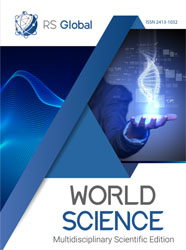PATHOGENESIS OF DEMYELINATING DISEASES IN TERMS OF ECOPATHOLOGY
Abstract
The experiment have been researched changes that may occur in the brains of people who worked or lived for a long time in an area of risk of permanent pollution with non-toxic doses of lead, 20-30 years after leaving the area. It was revealed that in the brain of experimental animals the number of neurons is reduced, gliosis, proliferation of microglia, destruction of blood vessels are noted, and processes of demyelination of white matter occur. These changes are more or less pronounced in all areas of the brain, to a greater extent in animals that received lead in more quantities. The identified morphological changes in the brain suggest that lead is one of the causes of the pathogenesis of demyelinating diseases.
References
Adachi, J.D., Arlen, D., Webber, C.E., Chettle, D.R., Beaumont, L.F., Gordon, C.L. (1998). “Is There any Associacion between the Presence of BoneDisease and Cumulative Exposure to Lead?” Calcif. Tissue. Int., 63 (5). 429-32. [in English].
Ahamed, M., Siddiqui, M.K. (2007). “Environmental Lead Toxicity and Nutritional Factors” clin. Nutr. 26(4). 400-8. [in English].
Arkhipova O.G., Zorina L.A., Sorkina N.S. (1975). “Kompleksony v klinike professional'nykh bolezney” [Complexons in the clinic of occupational diseases] M. izdatel'stvo Medicina [M. Publishing house Medicine]. [in Russian].
Chia, S.E., Chia, H.P., Ong, C.N., Jeyaratnam, J. (1996). “Cumulative Concentrations of Blood Lead and Postural Stability” Occup. Environ. Med. 53 (4). 264-8. [in English].
Canfield R. L. et al. (2003). “Intellectual impairment in children with blood lead concentrations below 10 microg per deciliter” N Engl J Med. 348(16). [in English].
Dehghanian F., Nabavizadeh N., Kamali E, Moeinifar N., Motovali-Bashi M. (2018). “A Complete Review on Epigenetic Biomarkers in MS” Academic Press Neuroinflammation (Second Edition), p. 619-637. [in English].
Dobrovol'skiy V.V. (1983). “Geografiya mikroelementov: Global'noye rasseyaniye” [Geography of trace elements: Global dispersion] M. izdatel'stvo Mysl' [M. Publishing house Thought]. [in Russian].
GBD 2016 Multiple Sclerosis Collaborators (2019). “Global, regional, and national burden of multiple sclerosis 1990-2016: a systematic analysis for the Global Burden of Disease Study 2016” Lancet Neurol. 18 (3) p. 269-285. [in English].
Gelashvili, O.A. (2008). “Variant periodizacii biologicheski shodnyh stadij ontogeneza cheloveka i krysy” [Variant of Periodization of Biologically Similar Stages of Human and Rat Ontogenesis] Saratovskij nauchno-medicinskij zhurnal [Saratov Sci.-Med. J.] N4(22). 125-126. [in Russian].
Gracia R.C., Snodgrass W.R. (2007) “Lead Toxicity and Chelation Therapy” Am. J. Health Syst. Pharm. 64(1): p. 45-53. [in English].
Kaznacheev, V.P. (1983). “Ocherki teorii I praktiki ekologii cheloveka” [Essays on the theory and practice of human ecology] M. izdatel'stvo Nauka [M. Publishing house Science]. [in Russian].
Lanphear B.P., Dietrich K., Auinger P., Cox C. (2000) “Cognitive deficits associated with blood lead concentrations <10 microg/dL in US children and adolescents” Public Health Rep. 2000 Nov. [in English].
Markovitz M. (2000) “Lead poisoning: a disease for the next millennium” Curr. Probl. Pediatr., #30 p. 62-70. [in English].
Mineev V.G., Alekseev A.A., Trishina T.A. (1982). “Tyazhelyye metally v okruzhayushchey srede v usloviyakh sovremennoy khimizatsii. Soobshcheniye 2. Svinets” [Heavy metals in the environment under conditions of modern chemicalization. Message 2. Lead] Nauchnyy zhurnal Agroxïmïya N 2, 126-140 s [Sci. J. Agrochemistry N 2, 126-140 p]. [in Russian].
Mishra K. P., Shashi Bala Singh (2020) “Heavy Metals Exposure and Risk of Autoimmune Diseases: A Review” Archives of Immunology and Allergy Volume 3, Issue 2, p. 22-26 [in English].
Oxengendler G.I. (1982). “Yady i protivoyadiya” [Poisons and antidotes] L. izdatel'stvo Nauka Leningr. Otd. L. Publishing house Science Leningr. dept. [in Russian].
Pataia V. (2020) “Living Near Major Roadways Raises Risk of MS and Other Neurologic Ills, Study Says” https://multiplesclerosisnewstoday.com/news-posts. [in English].
Pataraia, G. et all (2017). “Eksperimental'naya model' otdalennykh rezul'tatov ekspozitsii svintsa” [Experimental model of long-term outcomes of lead exposure] J. Georgian Medical News, № 2 (263), 125-129 p. [in Russian].
Tareyev Ye.M., Bezrodnykh A.A. (1976). “Professional'nyye bolezni” [Occupational diseases] M. izdatel'stvo Medicina [M. Publishing house Medicine]. [in Russian].
Roche, L.M., Ramarpasad, R., Gerwel, B., Pearson, M., Stanbury, M.,O'Leary, K. (1998). “Evolution of a State Occupational Lead Exposure Registry:1986-1996” J. Occup. Environ. Med., 40 (12). - 1127-33. [in English].
Schwartz J. (1994) “Low-level lead exposure and children's IQ: a meta-analysis and search for a threshold” Environ Res. 65(1) p. 42-55. [in English].
Simpson S. Jr, Blizzard L., Otahal P., Van der Mei I., Taylor B. (2011) “Latitude is significantly associated with the prevalence of multiple sclerosis: a meta-analysis” Neurol Neurosurg Psychiatry. 82(10):1132-41. [in English].
Sidhu Pardeep, Nehru Bimla (2004) “Lead Intoxication: Histological and Oxidative Damage in Rat Cerebrum and Cerebellum. Article in The Journal of Trace Elements in Experimental Medicine17(1) p. 45 - 53. [in English].
Solberg, W., Steinnes, E. (1983). “Heavy Metal Contemination of AccresterialEcosystems from Longdistance Atmospheric Transport” J. HeavyMetals in the Environment. Int. Conf. Heidelberg. v. 1. 170- 173. [in English].
Srianujata, S. (1998). “Lead – the Toxic Metal to Stay with Human” J. Toxicol.Sci. 23 Suppl. 2.- 237-40. [in English].
Torchinsky Yu.M. (1971) “ Sul'fgidril'nyye i sul'fgidril'nyye gruppy belkov” [Sulfhydryl and sulfhydryl groups of proteins] M. izdatel'stvo Nauka [M. Publishing house Science]. [in Russian].
Voroncov, A.I., Haritonova, N.Z. (1977). “Ohrana prirody” [Protection of Nature] M. izdatel'stvo Vysshaja shkola [M. Publishing house Higher School]. [in Russian].
Zook BC, London WT, Wilpizeski CR, Sever JL. (1980) “Experimental lead paint poisoning in non-human primates”. III Pathologic findings. Brain Res. 9(6) p. 343-360. [in English].
Views:
266
Downloads:
110
Copyright (c) 2023 Pataraia Giorgi, Mermanishvili Tatiana, Tchatchia Grigol

This work is licensed under a Creative Commons Attribution 4.0 International License.
All articles are published in open-access and licensed under a Creative Commons Attribution 4.0 International License (CC BY 4.0). Hence, authors retain copyright to the content of the articles.
CC BY 4.0 License allows content to be copied, adapted, displayed, distributed, re-published or otherwise re-used for any purpose including for adaptation and commercial use provided the content is attributed.














